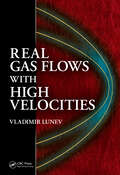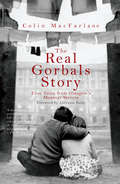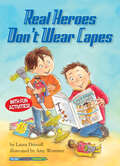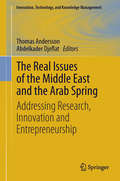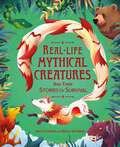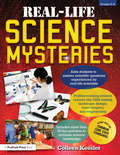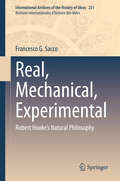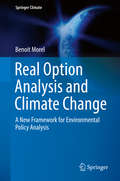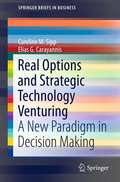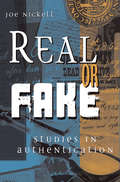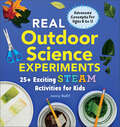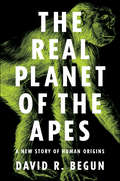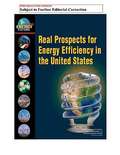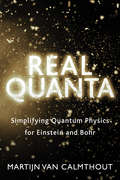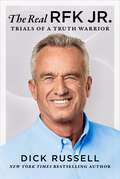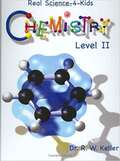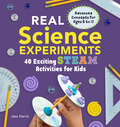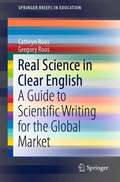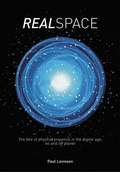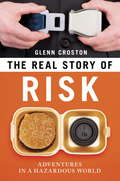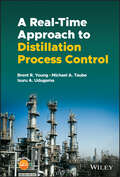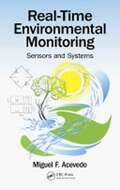- Table View
- List View
Real Economics for Real People (3rd Edition)
by Charles L. BallardEconomics applied to everyday life.
Real Engineering Experiments: 25+ Exciting STEAM Activities for Kids (Real Science)
by Anthony TegtmeyerSTEAM-powered experiments in engineering for kids ages 8 to 12 Learn about the amazing world of engineering for kids and how it works together with science, technology, art, and math. Whether you're experimenting with structures, materials, mechanics, or electrons, this book offers step-by-step instructions and full-color pictures that help you answer questions like "what can we use magnetism for?" and "how do catapults work?" This guide to engineering for kids features: Engineering explained—Dive deep into what it means to be an engineer as you learn about the different types of engineers and how they approach challenges. Amazing experiments—Build a robot, make your own battery, clean polluted water, create a wind-powered car, and more using basic items you might already have at home. Beginner guidance—Find explanations for why each experiment works, as well as suggestions for taking them even further. Explore the amazing world of engineering for kids with these fun experiments that will get kids excited about learning.
Real Gas Flows with High Velocities
by Vladimir V. LunevDespite generations of change and recent, rapid developments in gas dynamics and hypersonic theory, relevant literature has yet to catch up, so those in the field are generally forced to rely on dated monographs to make educated decisions that reflect present-day science. Written by preeminent Russian aerospace researcher Vladimir V. Lunev, Real Ga
The Real Gorbals Story: True Tales from Glasgow's Meanest Streets
by Colin MacFarlaneColin MacFarlane was born in the Gorbals in the 1950s, 20 years after the publication of No Mean City, the classic novel about pre-war life in what was once Glasgow's most deprived district. He lived in the same street as its fictional 'razor king', Johnnie Stark, and subsequently realised that a lot of the old characters represented in the book were still around as late as the 1960s. Men still wore bunnets and played pitch and toss; women still treated the steamie as their social club. The razor gangs were running amok once again, and filth, violence, crime, rats, poverty and drunkenness abounded, just like they did in No Mean City.MacFarlane witnessed the last days of the old Gorbals as a major regeneration programme, begun in 1961, was implemented, and, as a street boy, he had a unique insight into a once great community in rapid decline. In this engrossing book, MacFarlane reveals what it was really like to live in the old Gorbals.
Real Heroes Don't Wear Capes: Heroes (Social Studies Connects)
by Laura DriscollThe popular Social Studies Connects series links history, geography, civics and economics to kids&’ daily lives. Featuring stories with diverse characters who face situations young readers can relate to, these books support reading and social studies skills including researching, inferring, comparing, and communication. An activity to stimulate curiosity about the world is included in each book!With no special powers, no secret identity, and no cape, can someone be a real hero? Ethan thinks so and sets out to prove it! (Social Studies Topic: History & Culture/Heroes)
The Real Issues of the Middle East and the Arab Spring
by Abdelkader Djeflat Thomas AnderssonThe wave of protests and populist uprisings in the Middle East has heightened the focus on a volatile region. But the emphasis on political issues has obscured underlying issues concerning education, infrastructure, research, innovation, entrepreneurship and sustainable economic and social development. This volume, emerging in the aftermath of a conference and workshop on science and technology in the region, presents contributions from a range of experts from the Middle East, Europe, and the United States to provide fresh new insights and perspectives on the challenges and prospects for regional development in the changing global context of our time. The authors explore such topics as: the role of information and communication technologies; mindset change in support of investment in intangible assets and risk-taking; how to approach cultural issues, institutions and governance; collaborations with other regions, and; benchmarking performance while drawing lessons of relevance for the special local context. Ultimately, they offer a number of precise policy recommendations and practical insights for creating an enabling environment for capturing economic, political, and social opportunity.
Real-life Mythical Creatures and Their Stories of Survival (Real-life Monsters)
by Anita GaneriImmerse yourself in the fascinating stories of ten real-life mythical creatures, exploring the legends that surround them, their discoveries and seeing how they survive today.From blood-sucking vampires and fiery phoenixes, to howling werewolves and shaggy-haired yetis, mysterious, and often mischievous, creatures appear in myths and legends from around the world. For centuries, they have puzzled, fascinated and frightened people, sometimes being used to teach a lesson or to warn of danger. But have these beasts ever really existed, and, most importantly, are any of them around today?This book brings together ten real-life mythical creatures, with fascinating facts and folklore. There are tales of how they were discovered, where they live, and about their adaptations for surviving in the wild.It's time to set off on the mythical monster hunt of a lifetime.ENTER IF YOU DARE!This high-interest approach to the natural world shows the diversity of nature, evolution and adaptation and can be used to support the science curriculum study of living things at key stage two.Full-colour photographs combined with illustrations make this a beautiful and fascinating introduction to real-life mythical creatures around the world.
Real-Life Science Mysteries: Grades 5-8
by Colleen KesslerReal-Life Science Mysteries puts an exciting new spin on scientific thinking by profiling real-life scientists, showing students in grades 5-8 ways they can use science in their everyday lives. From a biologist studying the habits of garter snakes in Manitoba, Canada, to a landscape designer and greenhouse owner in Ohio, the scientists in this book share information and solutions to the thorniest problems they face in their scientific careers.With the more than 30 activities included in Real-Life Science Mysteries, students will be required to try their hand at solving common science problems and performing experiments while learning about real people from diverse backgrounds, all of whom share a love for discovering how they work, why things work, and how they can work better. This book is perfect for any science classroom or young scientists looking to increase their knowledge!Grades 5-8
Real, Mechanical, Experimental: Robert Hooke's Natural Philosophy (International Archives of the History of Ideas Archives internationales d'histoire des idées #231)
by Francesco G. SaccoThis original work contains the first detailed account of the natural philosophy of Robert Hooke (1635-1703), leading figure of the early Royal Society. From celestial mechanics to microscopy, from optics to geology and biology, Hooke’s contributions to the Scientific Revolution proved decisive. Focusing separately on partial aspects of Hooke’s works, scholars have hitherto failed to see the unifying idea of the natural philosophy underlying them. Some of his unpublished papers have passed almost unnoticed. Hooke pursued the foundation of a real, mechanical and experimental philosophy, and this book is an attempt to reconstruct it. The book includes a selection of Hooke's unpublished papers. Readers will discover a study of the new science through the works of one of the most known protagonists. Challenging the current views on the scientific life of restoration England, this book sheds new light on the circulation of Baconian ideals and the mechanical philosophy in the early Royal Society. This book is a must-read to anybody interested in Hooke, early modern science or Restoration history.
Real Option Analysis and Climate Change: A New Framework for Environmental Policy Analysis (Springer Climate)
by Benoit MorelThis book sets out to reframe the theory of real options so that it can be used to support environmental investments for climate change adaptation and mitigation. Climate change policy often involves making decisions that concern extended time periods, and doing so under considerable uncertainty. By expanding and broadening the framework of real options, this book first introduces readers to new ways of quantifying investment decisions that can much more effectively address the shape and size of the uncertainty than traditional approaches using Net Present Value. In turn, the second part of the book applies this new theoretical framework to climate change policy by presenting a number of examples, and by providing a general perspective on investment decisions related to climate change and how to prioritize them.
Real Options and Strategic Technology Venturing
by Caroline M. Sipp Carayannis Elias G.This book seeks to answer "why, when and how are real options used in strategic technology venturing?" This work tests for the role of real options in decision making involving three types of firms in decreasing order of technology-dependence - technology-driven (TD) (where the profit is fully dependent on new technology creation and leveraging), technology-based (TB) (where the profit is enabled and supported by technology) and technology-neutral (TN) (where the profit is almost independent of technology). It also deals with strategic and non-strategic types of decisions driven by real options. This analysis shows that an environment presenting co-opetitive (simultaneous competition and collaboration) conditions triggers the use of real options (why), that serve to transform the position, posture and propensity of businesses to innovate and thus they co-evolve (when) into more effective and efficient forms of businesses (co-specialization) (how). The authors demonstrate that embracing risk and uncertainty can increase levels and probability of new venture formation. However, their simulation also shows that it should be adapted to the risk profile of the firm and that timing is also a factor to be considered. Although engaging the concepts of real options, this analysis does not focus on a specific investment valuation methodology, but highlights the relationship between knowledge and risk and rather addresses the management of mindsets, as moving towards a systematic conceptualization of real options represents a different paradigm in decision making.
Real or Fake: Studies in Authentication
by Joe NickellThe man who is “the embodiment of the Mythbusters, Sherlock Holmes, and Richard Feynman” weeds out the treasures from the shams in artifact investigations (Michael Shermer, founding publisher of Skeptic magazine).Detailing how the pros determine whether an Abraham Lincoln signature is forged or if a photograph of Emily Dickinson is genuine, Nickell, a leader in forgery detection and forensic investigation, provides the essential tools necessary to identify counterfeits. In this general introduction to the principles of authentication, Nickell provides readers with step-by-step explanations of the science used to detect falsified documents, photographs, and other objects, illustrating methods used on hit shows such as Antiques Roadshow and History Detectives.Including fascinating cases drawn from Nickell’s illustrious career, Real or Fake combines historical and scientific investigations to reveal reproductions and genuine objects. Nickell explains the warning signs of forgery, such as patching and unnatural pen lifts; chronicles the evolution of writing instruments, inks, and papers; shows readers how to date photographs, papers, and other materials; and traces the development of photographic processes since the mid-nineteenth century. Lavishly illustrated with examples of replicas and authentic objects inspected by Nickell, Real or Fake includes case studies of alleged artifacts including Jack the Ripper’s diary, a draft of the Gettysburg Address, notes by Charles Dickens, Jefferson Davis’s musket, and debris from the Titanic.“An expert on antique ink and paper, and the forensic analysis of historic documents.” —The New Yorker“Nickell advocates a multifaceted approach that looks at provenance, content, material composition, and scientific analysis.” —Maine Antique Digest
Real Outdoor Science Experiments: 25+ Esciting STEAM Activities for Kids (Real Science Experiments)
by Jenny BallifHypothesis: You'll love these real outdoor experiments for kids 8 to 12!Dive into the world's most exciting science project—the great outdoors! Covering everything from plants and trees to rocks and weather, this amazing book has real outdoor science experiments for kids, to immerse you in the wonders of science, technology, engineering, art, and math. Discover STEAM outdoors—Learn how the scientific method can help you unlock the secrets of the natural world. Make nature your laboratory—Conduct 30 cool experiments like creating grass ropes, making ink from plants, calculating latitude by the stars, and more. Find answers to your questions—How do sinkholes form? Are leaves in the shade bigger or smaller than leaves in the sun? Get explanations for the science behind each experiment, plus ideas for taking your experiments even further. Get ready to explore the science happening all around you with Real Outdoor Science Experiments.
The Real Planet of the Apes
by David R. BegunWas Darwin wrong when he traced our origins to Africa? The Real Planet of the Apes makes the explosive claim that it was in Europe, not Africa, where apes evolved the most important hallmarks of our human lineage--such as dexterous hands and larger brains. In this compelling and accessible book, David Begun, one of the world's leading paleoanthropologists, transports readers to an epoch in the remote past when the Earth was home to many migratory populations of ape species.Drawing on the latest astonishing discoveries in the fossil record as well as his own experiences conducting field expeditions across Europe and Asia, Begun provides a sweeping evolutionary history of great apes and humans. He tells the story of how one of the earliest members of our evolutionary group--a new kind of primate called Proconsul--evolved from lemur-like monkeys in the primeval forests of Africa. Begun vividly describes how, over the next 10 million years, these hominoids expanded into Europe and Asia and evolved climbing and hanging adaptations, longer maturation times, and larger brains, setting the stage for the emergence of humans. As the climate deteriorated in Europe around 10 million years ago, these apes either died out or migrated south, reinvading the African continent and giving rise to the lineages of the gorilla, chimpanzee, and, ultimately, the human.Presenting startling new insights about our fossil ape ancestors, The Real Planet of the Apes is a book that fundamentally alters our understanding of human origins.
Real Prospects for Energy Efficiency in the United States
by National Academy Of Sciences National Academy of Engineering National Research Council of the National AcademiesFor multi-user PDF licensing, please contact mailto:customer_service@nap.edu customer service. America's economy and lifestyles have been shaped by the low prices and availability of energy. In the last decade, however, the prices of oil, natural gas, and coal have increased dramatically, leaving consumers and the industrial and service sectors looking for ways to reduce energy use. To achieve greater energy efficiency, we need technology, more informed consumers and producers, and investments in more energy-efficient industrial processes, businesses, residences, and transportation. As part of the America's Energy Future project, Real Prospects for Energy Efficiency in the United States examines the potential for reducing energy demand through improving efficiency by using existing technologies, technologies developed but not yet utilized widely, and prospective technologies. The book evaluates technologies based on their estimated times to initial commercial deployment, and provides an analysis of costs, barriers, and research needs. This quantitative characterization of technologies will guide policy makers toward planning the future of energy use in America. This book will also have much to offer to industry leaders, investors, environmentalists, and others looking for a practical diagnosis of energy efficiency possibilities.
Real Quanta: Simplifying Quantum Physics for Einstein and Bohr
by Martijn Van CalmthoutAlbert Einstein and Niels Bohr walk into the famous Hotel Métropole and sit down at the author’s table to discuss the state of quantum mechanics today. Particles that exist in two places at once, consequences that occur without a cause, objects that exist only if you look at them — quantum mechanics proves that all of this is possible, and not just in dark science labs. Look no further than your smartphone or tablet for technology made conceivable by quantum theory. From quantum computers to “teleporting” data, medicine to photosynthesis and the quantum compass in some migratory birds, Martijn van Calmthout plainly explains — to his readers and to an astounded Einstein and Bohr — how Quantum 2.0 is increasingly part of everyone’s daily life. Rather than being the exceptional domain, Van Calmthout shows how quantum mechanics is actually part of our tangible world, and may even be the very crux of our existence.
The Real RFK Jr.: Trials of a Truth Warrior
by Dick RussellAn epic biography filled with drama, conflict, and surmounted challenges.The Real RFK Jr. is an intimate biographical portrait examining the controversial activist's journey from anguish and addiction to becoming the country's leading environmental champion fighting government corruption, corporate greed, and a captured media. Written by his longtime colleague Dick Russell, the biography also exposes the misconceptions and explains the rationale behind Kennedy's campaign to protect public health. Provided exclusive source material, including access to Kennedy&’s unpublished writings and personal journals, the author conducted dozens of interviews with him as well as numerous friends and associates. Russell delves into everything from Kennedy&’s sometimes death-defying river rafting adventures to his pioneering legal cases against polluters such as Smithfield Foods and Monsanto, while founding the world&’s largest water protection group. The Real RFK Jr. also examines Kennedy&’s pursuit of the truth about the assassinations of his father and uncle, the wrongful murder conviction of his cousin, and the false narratives around the COVID-19 pandemic.
Real Science-4-kids Chemistry Level 2 Student Text
by Rebecca Keller KellerReal Science-4-Kids, Chemistry Level II, Student Textbook
Real Science Experiments: 40 Exciting STEAM Activities for Kids (Real Science)
by Jessica HarrisTake your scientific exploration to the next level with real experiments for kids ages 8 to 12 Here's a hypothesis you can prove: science is a ton of fun! These science experiments for kids give you the opportunity to test this theory using 40 exciting activities that teach you all about science, technology, engineering, art, and math—the full STEAM package! From microscopes and candle-powered boats to insect mind control and hydroponics, these science experiments for kids offer a hands-on approach to scientific discovery. Each of these engaging and repeatable experiments give you the chance to get up-close, personal, and creative with all kinds of amazing ideas that will show you how to be a real scientist. This collection of science experiments for kids includes: STEAM for you—Take STEAM learning into your own hands with awesome, easy-to-do science experiments for kids that are perfect for doing at home. Science made simple—From hypothesis to observation to results, learn all about the power of the scientific method—and how you can use it every day. Hows and whys—Each of these science experiments for kids details exactly why things happen the way they do, helping you better understand the results you see. Take your first step into a world of scientific discovery with the help of these amazing science experiments for kids.
Real Science in Clear English: A Guide to Scientific Writing for the Global Market (SpringerBriefs in Education)
by Cathryn Roos Gregory RoosThis book is a timely go-to resource for any professionals wishing to communicate with the growing number of readers whose first language is not English. It highlights the potential language difficulties these readers face, and provides guidelines and tools for overcoming them. The guidelines show how to convey complicated information clearly without affecting the integrity of the subject matter, while the practical ‘before’ and ‘after’ examples clearly illustrate how using these guidelines and improves scientific texts. The book also includes text evaluation tools that allow writers to rapidly assess the readability of their materials. It is based on theory and the authors’ extensive experience in producing highly readable English texts for L2 readers who struggle with materials that were originally prepared for L1 readers.
Real Space: The fate of physical presence in the digital age, on and off planet
by Paul LevinsonIs planet earth the end of the line, or is space itself the next stop?Cyberspace. It's incredible, taking us to any part of the planet we want to visit. But as Paul Levinson shows in his brilliant new book, when it comes to transport, we're still stuck in the past, preferring to take our bodies with us. Whether it's trains, yachts, scooters or pogo-sticks, we're compelled to keep moving, our movements curtailed only by the earth itself. In our imaginations however, we soar way past the limits of current technology. With a lucid but reflective style that takes in everything from robots and science fiction to religion and philosophy, Paul Levinson asks why there is a deep seated human desire to know what's 'out there'. Why, after getting a man on the moon, did the US space program develop so slowly? In a world where space is constantly repackaged, how do we know what real space is? Is our desire to get into space natural, or a religious craving, and is it a modern phenomenon, or did our ancestors also dream of escaping the clutches of Mother Earth? Jam-packed with exciting, innovative, even revolutionary thinking about our future, Realspace is essential reading for everyone who has ever sat at their desk, gazed into the distance and imagined boarding a space shuttle...
The Real Story of Risk
by Glenn CrostonOffering a wealth of fascinating information about health, sex, money, safety, food, and the environment, this book illuminates an often-misunderstood but crucial aspect of daily life. We live in a world of risk. It waits for us in our refrigerator and surrounds us on the freeway. It's lurking in our arteries and sitting in our 401(k) accounts. Given that we deal with risk on a constant basis, we should be good at it; as it turns out, though, we're not. We're blind to common risks like heart disease (one in five deaths), but we shrink in fear from rare events like shark attacks (one in a million) and airplane crashes (one in twenty thousand). What accounts for our poor ability to perceive and react to the risks that really matter? Starting from an evolutionary perspective, the author traces our distorted perception of risk back to our ancestors, reminding readers that we are all the culmination of a long line of survivors who fought life-and-death threats such as attacks from wild animals, starvation, and disease. The fact that we have covered Earth with seven billion people is a testament to our skill at overcoming these risks. But our spectacular success has also produced our contemporary artificial world with new threats like climate change, chili dogs, and online gambling. Our brains, which evolved to deal with the ancient world, are ill equipped to process the new threats we face. Croston examines the many facets of our hazardous modern environment that we only dimly perceive. He explains why we let our guard down for a beautiful face, why slow-moving risks (like rising seas) are hard to stop, how a good story (though false) can be more persuasive than dry statistics (even alarming ones), what we fear even more than death, and many other intriguing quirks about our built-in incompetence to adequately handle present-day risks.
A Real-time Approach to Distillation Process Control
by Brent R. Young Michael A. Taube Isuru A. UdugamaA Real-Time Approach to Distillation Process Control A practical and hands-on discussion of modern distillation control In A Real-time Approach to Distillation Process Control, a team of distinguished researchers and industrial practitioners delivers a practical text combining hands-on and active learning using process simulation with discussions of the fundamental knowledge and tools required to apply modern distillation control principles. The book offers a balanced, real-time approach integrated with practical insights. It includes many exercises designed to be simulator agnostic that can be performed on the process simulator locally available to the reader. Readers will discover explorations of topics including distillation control hardware, distillation composition control, refinery versus chemical plant distillation control, distillation control tuning, advanced regulatory control, and more. They’ll also find: A thorough introduction to distillation fundamentals, as well as basic and advanced modern controls from a practical point of view Comprehensive explorations of known base controls combined with modern control practices Practical discussions of hands-on modelling and simulation exercises, allowing the reader to design and tune controls on a distillation column Fulsome treatments of control structure design integrated with controller tuning using a real-time approach Perfect for senior undergraduate and graduate students studying general process control or distillation process control, A Real-time Approach to Distillation Process Control will also benefit plant managers, production supervisors, startup supervisors, operations engineers, production engineers, and chemical engineers working in industry.
A Real-Time Approach to Process Control
by Donald P. Mahoney William Y. Svrcek Brent R. YoungWith resources at a premium, and ecological concerns paramount, the need for clean, efficient and low-cost processes is one of the most critical challenges facing chemical engineers. The ability to control these processes, optimizing one, two or several variables has the potential to make more substantial savings in time, money and resources than any other single factor. Building on the success of the previous editions, this new third edition of A Real-Time Approach to Process Control employs both real industry practice and process control education without the use of complex or highly mathematical techniques, providing a more practical and applied approach.Updated throughout, this edition:* Includes a brand new chapter on Model predictive Control (MPC)* Now includes wireless and web-based technologies* Covers bio-related systems* Details the new multivariable control measure developed by the authors* Includes PowerPoint slides and solutions to Workshop problems on the accompanying website: http://www.wiley.com/go/svrcek-real-time-3e From the reviews of previous editions:"Would appeal to practising engineers due to its "hands on" feel for the subject matter. But more importantly, the authors present these concepts as fundamentals of chemical engineering, in a way that is consistent with how professor teach at the universities." -Chemical Engineering Process (CEP)"The book has been beautifully crafted" -Engineering Subject Centre"Provides a refreshing approach to the presentation of process analysis and control" -The Chemical Engineer
Real-Time Environmental Monitoring: Sensors and Systems
by Miguel F. AcevedoThe natural environment is complex and changes continuously at varying paces. Many, like the weather, we notice from day to day. However, patterns and rhythms examined over time give us the bigger picture. These weather statistics become climate and help us build an understanding of the patterns of change over the long term. <p><p> Real-Time Environmental Monitoring: Sensors and Systems introduces the fundamentals of environmental monitoring, based on electronic sensors, instruments, and systems that allow real-time and long-term data acquisition, data-logging, and telemetry. <p><p> The book details state-of-the-art technology, using a practical approach, and includes applications to many environmental and ecological systems. In the first part of the book, the author develops a story of how starting with sensors, you can progressively build more complex instruments, leading to entire systems that end with databases and web servers. In the second part, he covers a variety of sensors and systems employed to measure environmental variables in air, water, soils, vegetation canopies, and wildlife observation and tracking. <p><p> This is an emerging area that is very important to some aspects of environmental assessment and compliance monitoring. Real-time monitoring approaches can facilitate the cost effective collection of data over time and, to some extent, negate the need for sample, collection, handling, and transport to a laboratory, either on-site or off-site. It provides the tools you need to develop, employ, and maintain environmental monitors.


